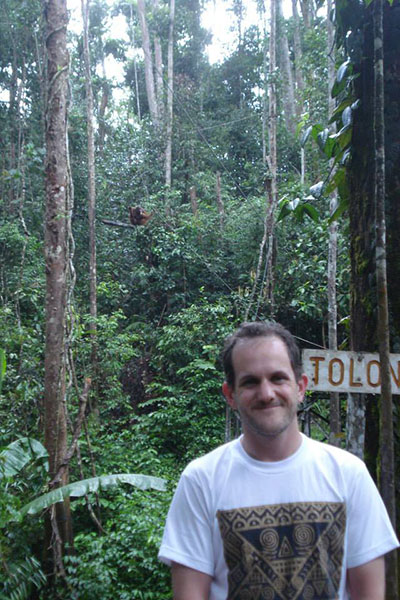Saving the 'land of the orangutan'
Our Curator of Vertebrate Zoology, John James Wilson reflects on Orangutan specimens in our collection. Collected by Alfred Russel Wallace (1823 - 1913), what is their significance today?

Alfred Russel Wallace is best known as the co-discoverer of the theory of evolution by natural selection, alongside Charles Darwin. In 1869, he also wrote The Malay Archipelago: The land of the orang-utan, and the bird of paradise, which firmly established Wallace as one of the greatest natural history explorers of our time. A narrative of travel, with studies of man and nature, the book is a vivid, first-person account of Wallace’s travels, studies and natural history collecting in Southeast Asia.
During 8 years Wallace travelled over 14,000 miles and collected 125,000 specimens. This included orangutans in Sarawak, Borneo, which are now generally considered to be a single species (Pongo pygmaeus), with a single subspecies found in Sarawak. However, Wallace and his contemporaries thought these animals comprised multiple species, including 'Simia satyrus' and 'Simia morio'. The book recounts Wallace’s collection of around twenty orangutans, about ten of which he sadly shot himself.
He writes:
“… one of my chief objects in coming to stay at Simunjon [a river in Sarawak] was to see the Orang-utan (or great man-like ape of Borneo) in his native haunts, to study his habitats, and obtain good specimens of the different varieties and species of both sexes, and of the adult and young animals. In all these objects I succeeded beyond my expectations…”
Wallace’s hard-headed hunting is dramatically countered as he recalls fostering a “poor little thing”, a female baby orangutan orphaned after her mother was shot out of the canopy.
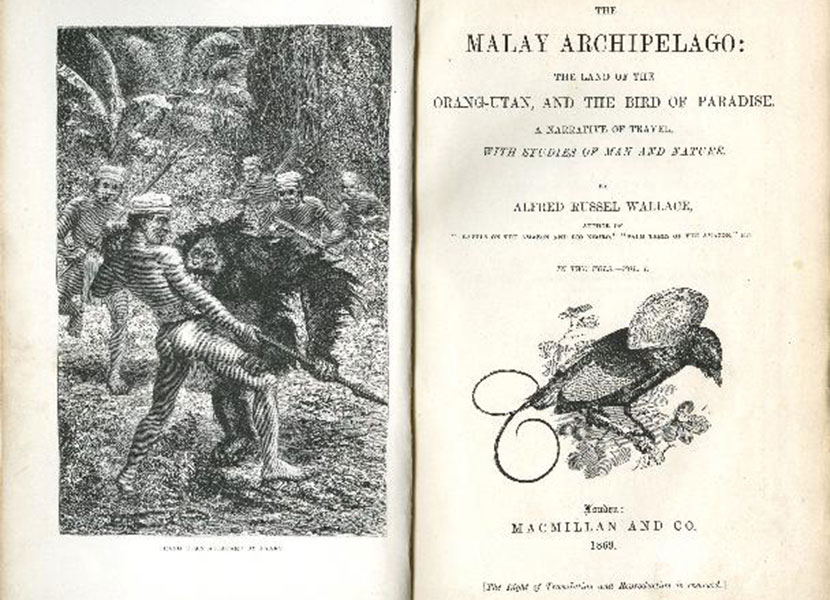
Among the orangutans collected by Wallace in Sarawak, he specifically mentions:
- the first full grown specimen he obtained, a female
- a “giant” male with a perfectly preserved skeleton
- the “only other male specimen of Simia morio” as being in the Derby Museum
World Museum was originally called the Derby Museum in honour of the 13th Earl of Derby whose natural history collection founded the Liverpool public museums. In total, five orangutans obtained by Wallace in Sarawak had arrived at World Museum on the 18th March 1857, purchased through Wallace’s London agent Samuel Stevens. These included:
- one adult male Simia satyrus (stuffed skin and mounted skeleton)
- one adult female Simia satyrus (stuffed skin and mounted skeleton)
- one juvenile Simia satyrus (stuffed skin)
- one adult male Simia morio (stuffed skin and articulated skull)
- one adult female Simia morio (stuffed skin and articulated skull)
Of these specimens the Simia morio male and female skulls can still be found in the World Museum collection.
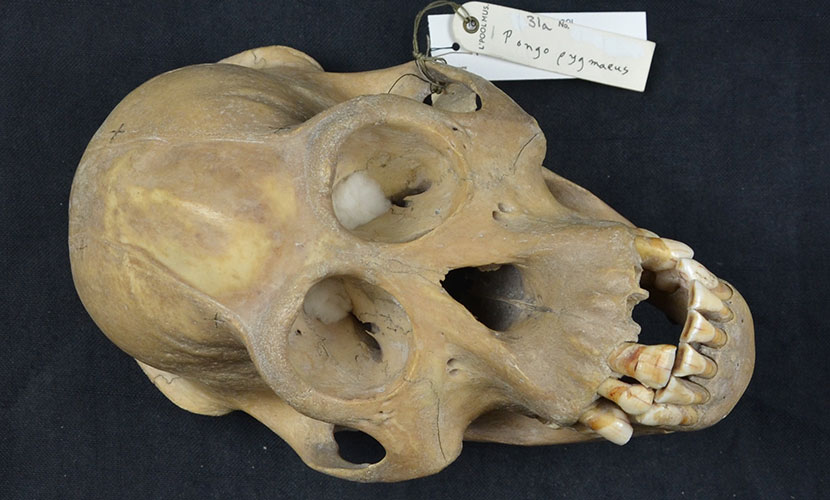
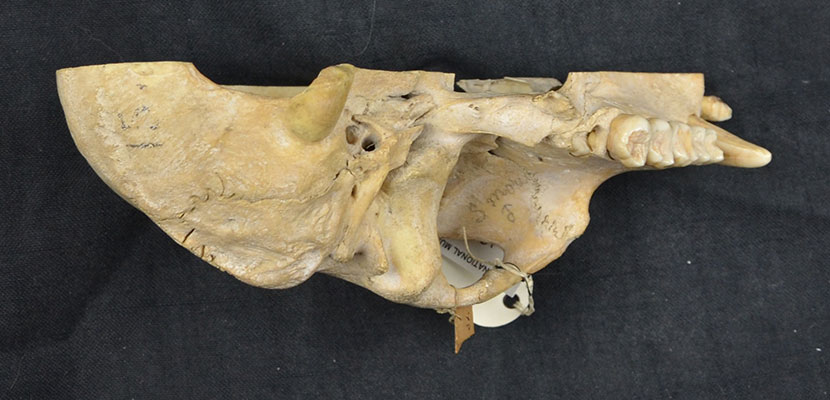
The cranium was likely sectioned into two for the Ascent of Man display. At this point the mandible became separated from the cranium and was accessioned into the collection as a 'chimpanzee'. Both are inscribed with 'S. morio' (catalogue number 31) and have now been reunited. For some fortunate reason the male Simia morio skin, shipped in a casket of arrack, was never mounted as a taxidermy specimen so didn’t go on display in the gallery. It remains folded (now dry) as originally received demonstrating Wallace’s procedure for preservation and packing.
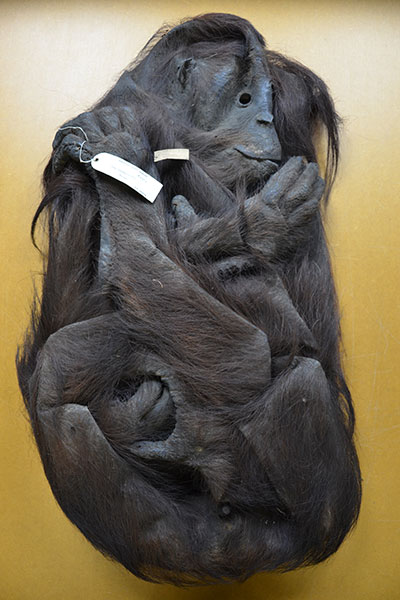
It is likely the other skins and mounted skeletons were prepared for public display and lost in the museum’s Upper Horseshoe Gallery during the Blitz of 3 May 1941. The orangutans appear to have been mounted similarly to those collected by Wallace in Sarawak and now in the Natural History Museum, London.
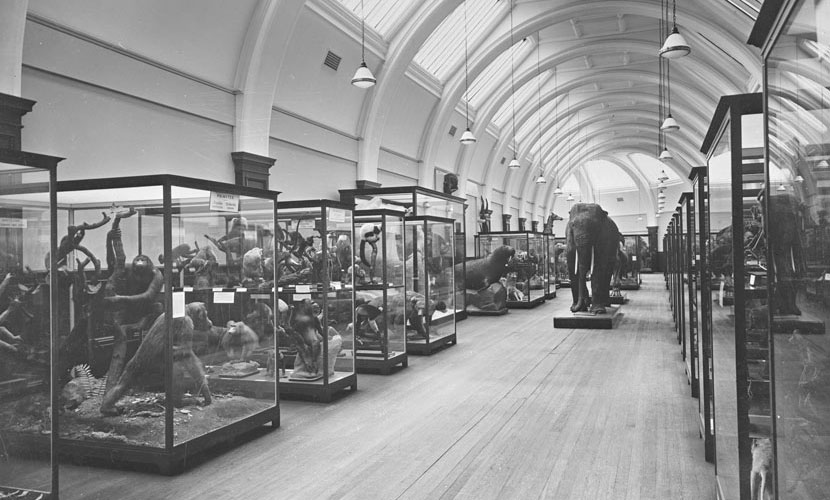
Wallace’ reputation has fared well in the century since his death, with this book review from The Guardian asserting him as:
“An adventurer who does not present himself as adventurous; he is a Victorian Englishman abroad with all the self-assurance but without the lordly superiority of the coloniser; he is the chronicler of wonders who refuses to exaggerate...”.
However, there is an impetus to recognise the local people who enabled Wallace’s achievements – the Dayak, Malay, ethnic Chinese and other indigenous peoples of Sarawak. In 2018 the Lee Kong Chian Natural History Museum in Singapore unveiled a statue of Wallace and Ali, Wallace’s “faithful companion of almost all my journeyings among the islands of the far East”.
As a researcher and lecturer working in Malaysia, I attended the 2013 Alfred Russel Wallace - His Predecessors and Successors conference in Kuching, Sarawak. Like Wallace, close to 150 years before, I was eager “to see the Orang-utan (or great man-like ape of Borneo) in his native haunts”. I visited the Semenggoh Nature Reserve, a sanctuary run by the Sarawak State Government for semi wild orangutans which have been injured, orphaned or kept illegally as pets.
Habitat loss and hunting have greatly decimated the orangutan population of Borneo, with a 2018 study estimating that over 100,000 Bornean orangutans were lost between 1999 and 2015. This was brought to public attention in Iceland Food’s 2018 'banned' TV advert below.
The Malay Archipelago has inspired scientists, naturalists and novelists, from Joseph Conrad to David Attenborough. Let’s hope it can help inspire the current generation to do everything they possibly can to ensure the survival of the critically endangered orangutans of Borneo. You can find out more at Orangutan Outreach here.
